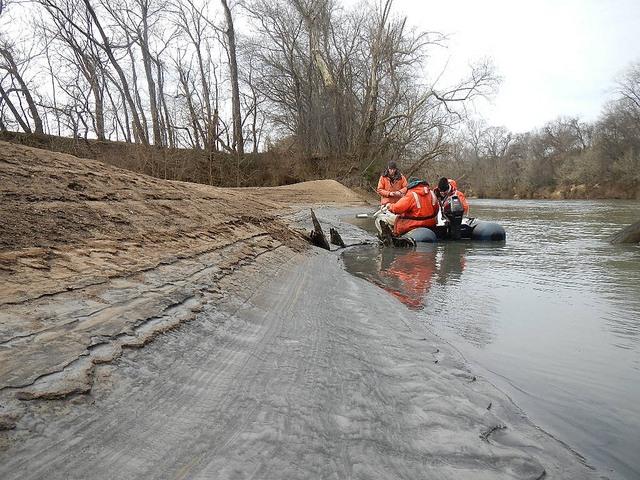
North Carolina legislators celebrated a victory this month: For the first time in years, they came up with a constructive strategy for dealing with Duke Energy coal ash dumps. Or, to put it more accurately, they came up with a strategy that is likely to make it past the governor's office.
The question is: Does the strategy prevent future coal ash spills? And will it ensure more oversight?
The answer to those questions fueled a call for third-party oversight of Duke Energy's coal ash sites. Legislation proposed last spring sought to create a new commission to oversee the closure of 14 Duke sites. As drafted, the bill would also provide new water systems for families living near existing coal ash ponds on Duke Energy's dime.
North Carolina Gov. Pat McCroy, a former Duke Energy employee, quickly vetoed the bill -- continuing a years-long fight against oversight by a third-party commission. In 2014, the governor sued the state and successfully argued that the installation of a separate agency to govern coal ash sites was in violation of the state constitution. The subsequent June 1 veto and the lack of third-party oversight forced the legislature to rewrite some of the requirements imposed on Duke Energy. In doing so, they shifted control back to the Department of Environmental Quality (DEQ), which is overseen by Gov. McCrory.
The coal ash leak lawsuit
But back to the original questions: Will the state's new concept protect homeowners and drinking water systems from any further leaks? And will it ensure the coal ash sites, which Duke Energy agrees must be closed, are taken out of commission?
The answer, some would say, can be found in a new lawsuit. The Southern Environmental Law Center (SELC) filed suit against Duke Energy on June 13, alleging that local water resources and recreational areas around Mayo Lake were being polluted by the company's adjacent coal ash site. SELC estimates that 6.9 million tons of coal ash have seeped out of an unlined containment area in the North Carolina site. But the real issue, says SELC, which filed the suit on behalf of the Roanoke River Basin Association, is that news of the leak went unheeded by Duke and both state and federal agencies.
"EPA and DEQ have not commenced and are not diligently prosecuting a civil or criminal action to redress the violations asserted in this citizen enforcement action," SELC and other environmental organizations allege in their complaint.
This is the second spill that the Roanoke River basin has faced in as many years. In 2014, Waterkeeper Alliance (a national advocacy group that includes the Roanoke River Basin Association) was able to prove that Duke Energy illegally pumped coal ash into the river to relieve a failing containment system. Some 300,000 tons of ash laced with heavy metals flowed downstream, polluting drinking water, wetlands and miles of a scenic river area.
Coal ash toxicity: Old data sources?
But the most recent problem, notes SELC, has nothing to do with failed piping. It has to do with Duke Energy's method of managing coal ash.
"In the nearly 40 years Duke Energy has stored coal ash at Mayo, it has never obtained a permit for discharges into Crutchfield Branch, for discharges into Mayo Lake by way of hydrologically-connected groundwater, or for disposing of pollutants in the state’s groundwater," SELC argues in its suit.
And that's where Duke Energy's interpretation of coal ash, heavy metal toxicity and federal requirements get sticky. According to the company's website, coal ash isn't really hazardous, because in small amounts it isn't really toxic.
"The U.S. Environmental Protection Agency has evaluated coal ash extensively and has repeatedly determined that it is not a hazardous waste," Duke Energy says in its handout, Coal Ash and Toxicity. Besides. "The trace elements in ash are measured in very small units."
But the reason it is measured in very small quantities is precisely because of its toxicity. According to the Physicians for Social Responsibility (PSR), the EPA has already begun to revise its statement on coal ash danger. In 2014, the federal agency took the first steps toward limiting the release of heavy metals from coal ash deposits (also called coal combustion residuals, CCRs). In 2015, it issued final guidelines for proper disposal (or recycling) of CCRs. The motivation for those new regulations, says the EPA, is that heavy metals "can pollute waterways, ground water, drinking water, and the air."
"The need for federal action to help ensure protective coal ash disposal was highlighted by large spills near Kingston, Tennessee, and Eden, North Carolina, which caused widespread environmental and economic damage to nearby waterways and properties."
Coal ash cleanup by 2028
But federal mandates like environmental limits on heavy metals don't mean that state legislatures will follow suit, especially when a governor's veto hangs in the balance. North Carolina Bill 630 does little, if anything, to back up EPA regulations. Instead, it does away with the rating system which determined that Mayo Power Plant's coal ash site (also known as the Roxboro Steam Electric Plant) was considered an intermediate-level threat to waterways and drinking resources.
While the bill expedites the cleanup of four "high-risk" coal ash sites, it extends the deadline for cleaning out others (like the Mayo Power Plant) until 2024.
It's a timeline that may make sense for North Carolina's biggest power company, inundated by the cost of revamping its coal ash system. But will it prove to be the best protection for North Carolina's homeowners, businesses and state tourism infrastructure? Time will undoubtedly tell.
Flickr/USFS Southeast Region
Jan Lee is a former news editor and award-winning editorial writer whose non-fiction and fiction have been published in the U.S., Canada, Mexico, the U.K. and Australia. Her articles and posts can be found on TriplePundit, JustMeans, and her blog, The Multicultural Jew, as well as other publications. She currently splits her residence between the city of Vancouver, British Columbia and the rural farmlands of Idaho.














